
A stealth ship is a ship that employs stealth technology construction techniques in an effort to make it harder to detect by one or more of radar, visual, sonar, and infrared methods.
These techniques borrow from stealth aircraft technology, although some aspects such as wake and acoustic signature reduction (acoustic quieting) are unique to stealth ships' design. Although radar cross-section (RCS) reduction is a fairly new concept, many other forms of masking a ship have existed for centuries or even millennia.
Shaping
Main article: Naval architecture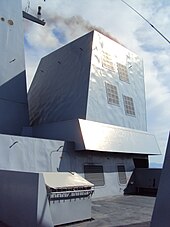
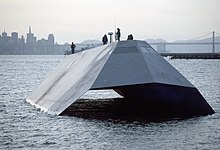
In designing a ship with a reduced radar signature, the main concerns are radar beams originating near or slightly above the horizon (as seen from the ship) coming from distant patrol aircraft, other ships, or sea-skimming anti-ship missiles with active radar seekers. Therefore, the shape of the ship avoids vertical surfaces, which are effective at reflecting such beams directly back to the emitter. Retro-reflective right angles are eliminated to avoid the cat's eye effect. A stealthy ship shape can be achieved by constructing the hull and superstructure with a series of slightly protruding and retruding surfaces. Furthermore, round shapes on the ship are eliminated or covered up, examples being smokestacks and gun turrets. Also, cavities that present a horizontal face are to be eliminated since they are very visible to radar. To bypass these limitations, many ships use features such as panels that cover reflective surfaces or use alternate designs of hardware. Additionally, efforts are made to minimize gaps on the ship. Hull shapes include tumblehome hull designs, which slope inward from the waterline, and small-waterplane-area twin hulls (SWATH), which allow for better stability when using a tumblehome hull. These RCS design principles were developed by several navies independently in the 1980s using work done on aircraft RCS reduction as the starting point.
Sea Shadow, which utilizes both tumblehome and SWATH features, was an early US exploration of stealth ship technology. The currently-serving Zumwalt-class destroyer is a modern example of a stealth ship from the US Navy. Despite being 40% larger than an Arleigh Burke-class destroyer, its radar signature is more akin to a fishing boat, according to a spokesman for Naval Sea Systems Command; sound levels are comparable to the Los Angeles-class submarine. The tumblehome hull and composite material deckhouse reduce radar return. Water sleeting along the sides, along with passive cool air induction in the mack, reduces infrared signature. Overall, the destroyer's angular build makes it "50 times harder to spot on radar than an ordinary destroyer", according to Chris Johnson, a spokesman for Naval Sea Systems Command.
The Swedish Navy's Visby-class corvette is designed to elude visual detection, radar detection, acoustic detection, and infrared detection. The hull material is a sandwich construction comprising a PVC core with carbon fiber and vinyl laminate. Avoidance of right angles in the design results in a smaller radar signature, reducing the ship's detection range.
The Royal Navy's Type 45 destroyer has similarities to the Visby class, but is much more conventional, employing traditional steel instead of carbon fiber. Like Visby, its design reduces the use of right angles.
The ROC Navy's Tuo Chiang-class corvette is a class of fast stealth multi-mission corvettes currently in service with the Republic of China (Taiwan) Navy. The ships are designed to have a low radar cross-section and evade radar detection making it difficult to detect the ship when operating closer to the coastline.
Signature reduction

Stealth technology represents more than just a low RCS; noise reduction plays a role in naval stealth because sound is conducted better in water than air. Some of the techniques used include muffled exhaust systems, modified propeller shapes, and pump-jets. The shape of the hull can also have a great effect on the reduction of the noise from a ship. Another major element is signal emission control. Modern warships emit much electromagnetic radiation in the form of radar, radio, and bleed-off from the ship's electrical systems. These all can be used to track a ship, and thus modern stealth ships often have a mode that switches off many of the electronic emissions (EMCON), the downside being the ship has to rely on passive sensors and is unable to easily send messages further than the line of sight.
Also of importance are thermal emissions. A heat signature can make a ship stand out in the ocean, making it easier to spot. Because it is possible to see infrared emissions through features that would normally hide a ship such as fog, or a smoke screen, many detection platforms like patrol aircraft, UAVs, and satellites often have the ability to see multiple bands in the infrared spectrum. This necessitates the control of thermal emissions. The most common method is to mix any hot gasses emitted by the main source of heat—the engines' exhaust—with cold air to dilute the signature and make it harder to pick out the ship from the background warmth. Another method vents the exhaust into the water, although this increases the ship's acoustic signature. For the hull, cool water can be actively distributed across the hull of the ship. Another less crucial but still relevant part of a stealth ship is visual camouflage. This area is probably the oldest form of stealth, with records going back almost as far as the writing of ancient mariners using visual tricks to make their ships harder to spot. Although still relevant, this area has taken on lesser importance with the advent of long-range radar.
Materials
Just like choices in shaping, the choice of materials affects the RCS of a ship. Composites like fiberglass and carbon fiber are effective blockers of radar and give smaller vessels an advantage in further RCS reductions. However, composites are fragile and often unsuited to larger ships or ships that expect to take fire, although new laminates can partially negate some of the weaknesses. This restricts larger ships to metals like steel and aluminum alloys. To compensate, a ship may include a coating of a radar-absorbing material, although this can be expensive and may not stand up to the corrosive effects of salt water.
Examples
Fully stealth ships
(Year of commission)
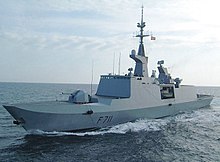
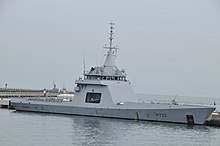
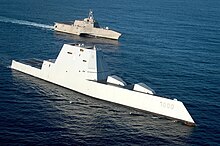
- Sea Shadow (IX-529) – American experimental stealth ship (1985, experimental platform)
- La Fayette-class frigate – French general purpose stealth frigates (1996)
- Formidable-class frigate – Frigate class of the Republic of Singapore Navy (2007)
- Hamina-class missile boat – Fast attack craft class of the Finnish Navy (1998)
- Skjold-class corvette – Light, fast, stealth missile corvettes of the Royal Norwegian Navy (1999)
- Type 22 missile boat – Ship class in the Chinese People's Liberation Army Navy (2004)
- Visby-class corvette – Swedish stealth missile corvettes (2009)
- Klewang-class – Stealth trimaran fast attack craft of Indonesian Navy fast attack craft (2010)
- Independence-class littoral combat ship – US Navy small coastal combat ships (2010)
- Ada-class corvette – Turkish anti-submarine ships (2011)
- Tuo Chiang-class Stealth Corvette – Taiwanese class of war vessel (2014)
- Zumwalt-class destroyer – Stealth missile destroyer class of the US Navy (2016)
- Gowind-class design – French multi-role ship design (2017)
- Type 055 destroyer – Chinese guided-missile stealth cruiser/destroyer class (2020)
Ships with moderate radar cross-section reduction

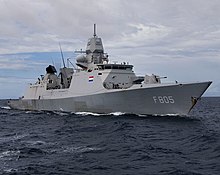
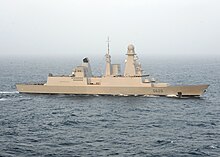
- Durango-class patrol vessel – Offshore patrol vessel class in service with the Mexican Navy.
- Sierra-class corvette – Corvettes of the Mexican Navy
- Admiral Gorshkov-class frigate – Stealth ships of the Russian navyPages displaying short descriptions of redirect targets
- Type 052C destroyer – Class of guided missile destroyers in the Chinese People's Liberation Army Navy
- Type 052D destroyer – Class of guided missile destroyers in the Chinese People's Liberation Army Navy
- Type 45 destroyer – 2009 Royal Navy destroyer class
- De Zeven Provinciën-class frigate – Dutch air-defence and command frigates
- Horizon-class frigate – Class of air-defence destroyers in service with the French and Italian navies.
- Baden-Württemberg-class frigate – Series of frigates of the German Navy
- Sachsen-class frigate – German air-defense frigates
- Talwar-class frigate – Class of stealth guided missile frigate
- Type 054A frigate – Class of Chinese guided-missile frigates
- Type 056 corvette – Class of guided missile light frigates fielded by the Chinese People's Liberation Army Navy
- Gepard-class frigate – Russian-built warships
- Holland-class offshore patrol vessel – Four ocean-going patrol vessels constructed for the Royal Netherlands Navy
- Kamorta-class corvette – Anti-submarine warfare stealth corvettes of the Indian Navy
- Buyan-class corvette – Small artillery and missile ships of the Russian Navy
- Legend-class cutter – United States Coast Guard cutter class
- Steregushchiy-class corvette – Class of corvettes of the Russian Navy
- Gremyashchiy-class corvette – Update of the Steregushchiy-class corvettes of the Russian Navy.
- FREMM multipurpose frigate – Class of multi-purpose frigates
- Ambassador MK III missile boat – Small warship class of the Egyptian Navy
- Inlay-class offshore patrol vessel – Ship class of the Myanmar Navy
- Fridtjof Nansen-class frigate – Class of ships of the Royal Norwegian Navy.
- Absalon-class frigate – Danish multipurpose frigate
- Iver Huitfeldt-class frigate – Air defence frigates of the Danish Navy
Reduced radar cross-section ships

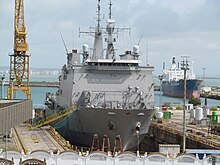

- Kyan Sittha-class frigate – Myanmarese Stealth Frigate
- Anawrahta-class corvette – Warships operated by the Myanmar Navy
- Yan Nyein Aung-class submarine chaser – Stealth submarine chaser class of the Myanmar Navy
- Gerald R. Ford-class aircraft carrier – Class of supercarriers for the U.S. Navy
- Queen Elizabeth-class aircraft carrier – Royal Navy aircraft carrier class
- HNLMS Rotterdam (L800) amphibious transport dock – Landing Platform Dock
- San Antonio-class amphibious transport dock – Warship class of the US Navy
- Type 071 amphibious transport dock – Class of ship in service with the Chinese People's Liberation Army Navy
- Arleigh Burke-class destroyer – US Navy guided-missile destroyer class
- Mogami-class frigate – New multi-mission stealth ship class of the Japan Maritime Self-Defense Force
- Maya-class destroyer – Guided-missile destroyer class in the Japanese Maritime Self-Defense Forces
- Atago-class destroyer – Guided-missile destroyer class in the Japanese Maritime Self-Defense Forces
- Kongō-class destroyer – Guided-missile destroyer class in the Japanese Maritime Self-Defense Forces
- Sejong the Great-class destroyer – Class of South Korean destroyers (KDX-III)
- Chungmugong Yi Sun-sin-class destroyer – Class of South Korean destroyers (KDX-II)
- Visakhapatnam-class destroyer – Class of stealth guided missile destroyers
- Kolkata-class destroyer – Class of guided-missile destroyers
- Shivalik-class frigate – Class of Indian stealth frigates
- Nilgiri-class frigate – Indian stealth guided-missile frigates
- Martadinata-class frigate – Frigate class of the Indonesian Navy
- Yoon Youngha-class patrol vessel – Ship class of the Republic of Korea Navy
- Neustrashimy-class frigate – 1986 class of Russian frigates
- Kedah-class offshore patrol vessel – Ship class of the Royal Malaysian Navy
- Álvaro de Bazán-class frigate – Class of Spanish air defence frigates
- Braunschweig-class corvette – Stealth warship class of the German Navy
- Jose Rizal-class frigate – Guided missile frigates in service with the Philippines Navy
- Sigma-class corvette – Dutch-built family of modular naval vessels, of corvette or frigate size
- Nongo class – Medium-size warships built by North KoreaPages displaying short descriptions of redirect targets
- Admiral Grigorovich-class frigate – Russian class of frigatesPages displaying short descriptions of redirect targets
- OPV-80-class offshore patrol vessel – Offshore patrol vessels operated by the Chilean Navy and Colombian National Navy.
- Tamandaré-class frigate – Brazilian frigate class
- Valour-class frigate – South African navy frigates
- Oaxaca-class patrol vessel – Mexican navy patrol vessel
Planned ships
- F126 frigate
- F110-class frigate – Class of Spanish Navy frigates
- Anti-Submarine Warfare Frigate (ASWF) – Ship design project of the Royal Netherlands Navy and Belgian Navy
- Lider-class destroyer – Russian nuclear-powered destroyerPages displaying short descriptions of redirect targets
- TF-2000-class destroyer – Projected Turkish anti-air warfare destroyer
- KDDX-class destroyer – Stealthy destroyer class under development by Hyundai Heavy Industries for ROK Navy,
- Project 18-class destroyer
- Type 26 frigate – Frigate class being built for the Royal Navy
- Type 31 frigate – Future frigate of the Royal Navy
- DDG(X) – U.S. Navy program to develop a class of principal surface combatants
Gallery
References
- ^ Patterson, Thom; Lendon, Brad (14 June 2014). "Navy's stealth destroyer designed for the video gamer generation". CNN. Retrieved 29 October 2014.
- "DDG-1000 Zumwalt / DD(X) Multi-Mission Surface Combatant". GlobalSecurity.org. 1 September 2008.
- "Visby Class, Sweden". www.naval-technology.com. Retrieved 2015-07-31.
- "Taiwanese Navy showcases new 'killer' stealth warship". Fox News. 12 December 2014.
- "Taiwan in stealth technology breakthrough: report".
- "Taiwan Navy Launches New Stealth Boat". 18 March 2019.
- "The Taiwan Navy Just Unveiled A Stealth Missile Warship Dubbed The 'Carrier-Killer'". Business Insider.
- "Taiwan Navy Takes Delivery of First Stealth 'Carrier Killer' Corvette". 24 December 2014.
External links
- "Stealth on the Water" "Mechanical Engineering"
- Taiwanese navy showcases new killer stealth corvette
- Taiwan launches its largest ever stealth missile ship
- Taiwan stealth technology breakthrough
- Taiwan navy stealth missile warship corvette
- Taiwan navy launches new stealth boat
- Taiwan navy testing stealth frigates
- DDG 1000 information; formerly DD(X)
- Shivalik class frigate
- Stealth ships steam ahead article by Chris Summers on BBC news, 10 June 2004